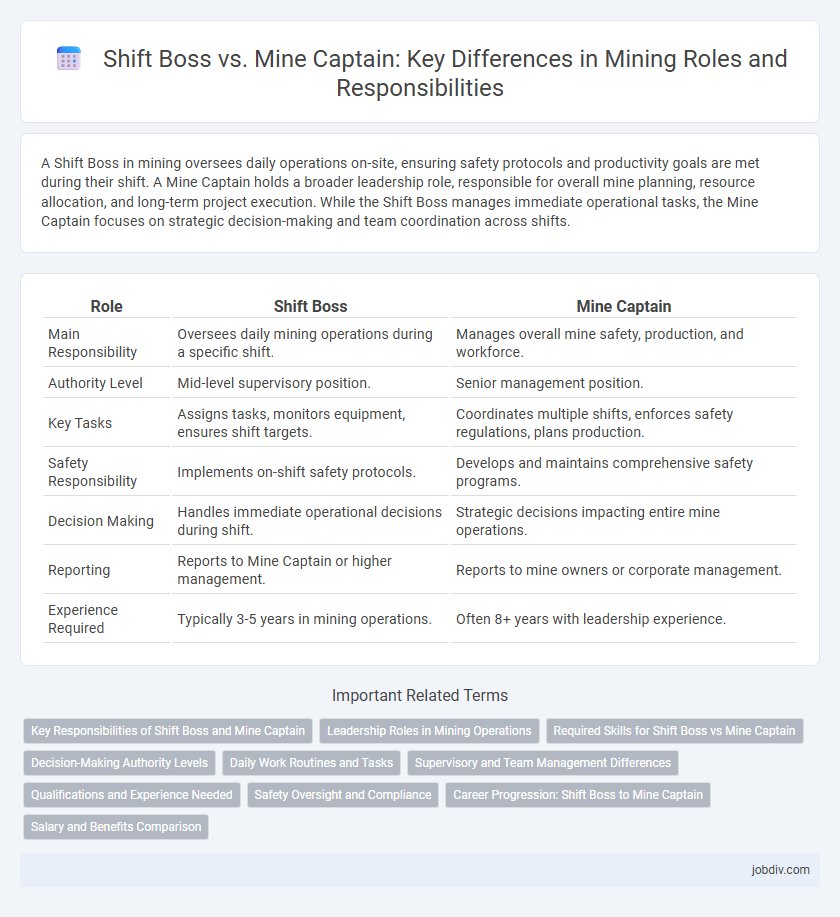A Shift Boss in mining oversees daily operations on-site, ensuring safety protocols and productivity goals are met during their shift. A Mine Captain holds a broader leadership role, responsible for overall mine planning, resource allocation, and long-term project execution. While the Shift Boss manages immediate operational tasks, the Mine Captain focuses on strategic decision-making and team coordination across shifts.
Table of Comparison
| Role | Shift Boss | Mine Captain |
|---|---|---|
| Main Responsibility | Oversees daily mining operations during a specific shift. | Manages overall mine safety, production, and workforce. |
| Authority Level | Mid-level supervisory position. | Senior management position. |
| Key Tasks | Assigns tasks, monitors equipment, ensures shift targets. | Coordinates multiple shifts, enforces safety regulations, plans production. |
| Safety Responsibility | Implements on-shift safety protocols. | Develops and maintains comprehensive safety programs. |
| Decision Making | Handles immediate operational decisions during shift. | Strategic decisions impacting entire mine operations. |
| Reporting | Reports to Mine Captain or higher management. | Reports to mine owners or corporate management. |
| Experience Required | Typically 3-5 years in mining operations. | Often 8+ years with leadership experience. |
Key Responsibilities of Shift Boss and Mine Captain
The Shift Boss oversees daily mining operations, ensuring safety protocols are followed, production targets are met, and workforce coordination is maintained on-site. The Mine Captain is responsible for strategic planning, supervising overall mine development, and ensuring compliance with regulatory standards across all shifts. Both roles demand expertise in operational efficiency, safety management, and team leadership to optimize mining productivity.
Leadership Roles in Mining Operations
Shift Boss and Mine Captain hold critical leadership roles in mining operations, with the Shift Boss primarily overseeing daily workforce management, ensuring safety compliance, and coordinating production activities on-site. The Mine Captain assumes a broader supervisory role, focusing on strategic planning, resource allocation, and maintaining operational efficiency across multiple shifts or sections of the mine. Both positions demand strong leadership skills, but the Mine Captain typically carries greater responsibility for long-term operational success and regulatory adherence.
Required Skills for Shift Boss vs Mine Captain
Shift Boss requires strong leadership, technical mining knowledge, and the ability to manage daily operations while ensuring safety compliance. Mine Captain demands advanced skills in strategic planning, resource allocation, and expertise in underground mining techniques to oversee overall mine production. Both roles require excellent communication, problem-solving abilities, and adherence to regulatory standards, but Mine Captain focuses more on long-term efficiency and team coordination.
Decision-Making Authority Levels
Shift Bosses oversee day-to-day operational decisions on the mining site, managing workforce allocation and addressing immediate safety issues. Mine Captains hold higher decision-making authority, responsible for long-term strategic planning, regulatory compliance, and overall production targets. The distinction in authority levels ensures effective operational control while aligning with corporate mining management objectives.
Daily Work Routines and Tasks
Shift Boss supervises daily mining operations by coordinating workforce assignments, monitoring equipment functionality, and ensuring safety protocols are followed onsite. Mine Captain oversees strategic task execution, analyzing production targets, conducting safety inspections, and managing emergency responses to maintain operational efficiency. Both roles prioritize communication with team members and reporting to upper management to streamline mining activities.
Supervisory and Team Management Differences
A Shift Boss oversees daily mining operations, ensuring safety protocols and productivity targets are met through direct supervision of frontline workers and equipment operators. The Mine Captain holds a broader managerial role, coordinating multiple shift bosses, managing overall mine production schedules, and implementing strategic workforce development. Shift Bosses focus on tactical team management and immediate problem-solving, while Mine Captains handle long-term planning and cross-team coordination for efficient resource extraction.
Qualifications and Experience Needed
A Shift Boss in mining typically requires a high school diploma or equivalent with extensive hands-on experience in underground or surface mining operations, emphasizing supervisory skills and safety management. In contrast, a Mine Captain often demands advanced qualifications such as a degree in mining engineering or related fields, coupled with comprehensive operational knowledge and leadership experience overseeing entire mine sections. Both roles necessitate strong communication abilities and a deep understanding of mining regulations, though the Mine Captain carries greater responsibility for strategic planning and resource management.
Safety Oversight and Compliance
Shift Boss supervises real-time operations on the mining site, ensuring strict adherence to safety protocols and immediate hazard mitigation to protect workers. Mine Captains oversee comprehensive safety compliance programs, enforce regulatory standards, and implement strategic safety policies across multiple shifts. Both roles are crucial for maintaining workplace safety, but Mine Captains typically focus on long-term compliance while Shift Bosses manage day-to-day operational safety.
Career Progression: Shift Boss to Mine Captain
Career progression from Shift Boss to Mine Captain involves gaining extensive operational experience and leadership skills within mining site management. Shift Bosses typically oversee daily crew activities, safety, and equipment operation, while Mine Captains assume broader responsibilities including strategic planning, regulatory compliance, and overall mine production targets. Advancement requires demonstrating proficiency in resource allocation, team coordination, and adherence to mining industry standards.
Salary and Benefits Comparison
Shift Bosses in mining typically earn a median salary ranging from $70,000 to $90,000 annually, with benefits including health insurance, retirement plans, and performance bonuses. Mine Captains command higher compensation, often between $95,000 and $120,000 per year, reflecting their greater responsibilities in overseeing entire mine operations and safety compliance. Benefits for Mine Captains often extend to enhanced retirement contributions, stock options, and comprehensive health coverage, making their total compensation packages more robust compared to Shift Bosses.
Shift Boss vs Mine Captain Infographic

 jobdiv.com
jobdiv.com